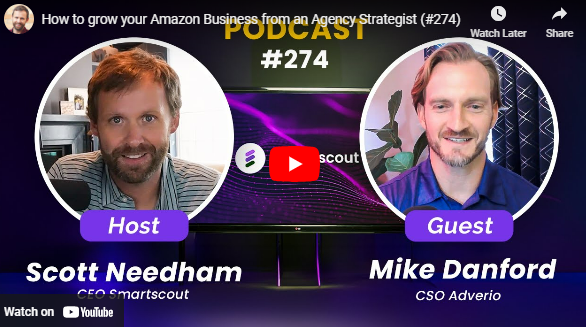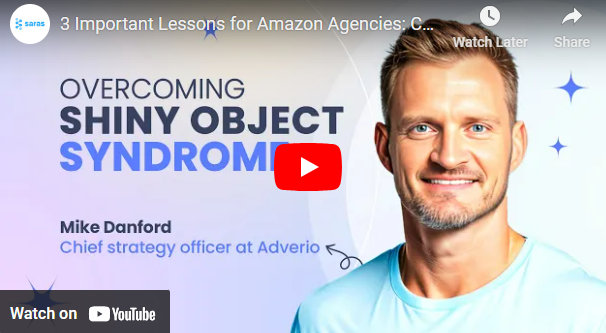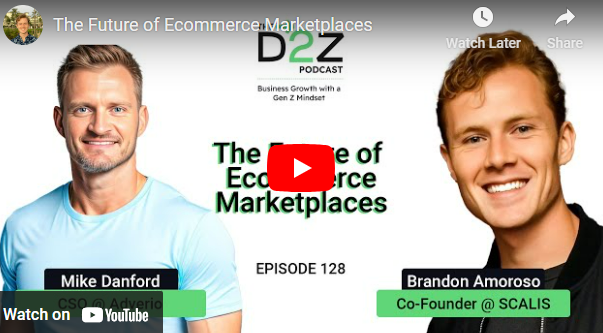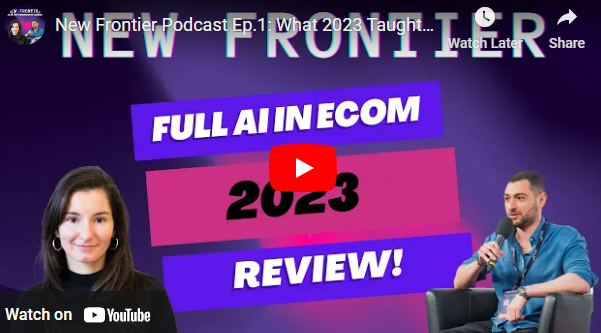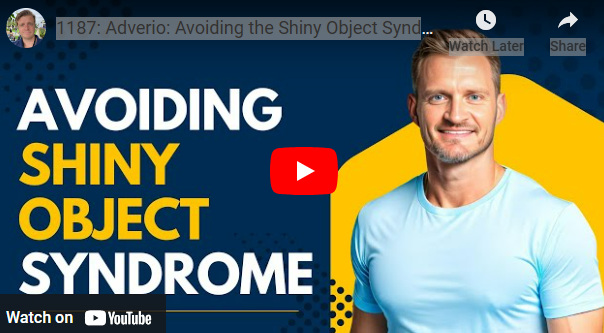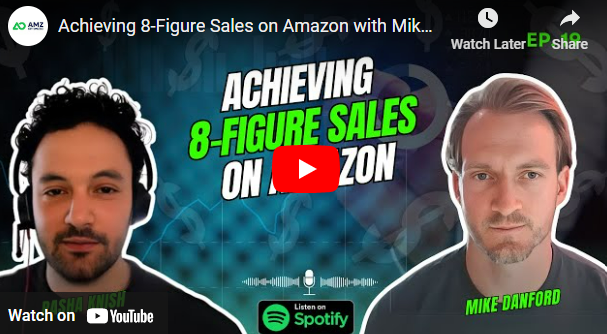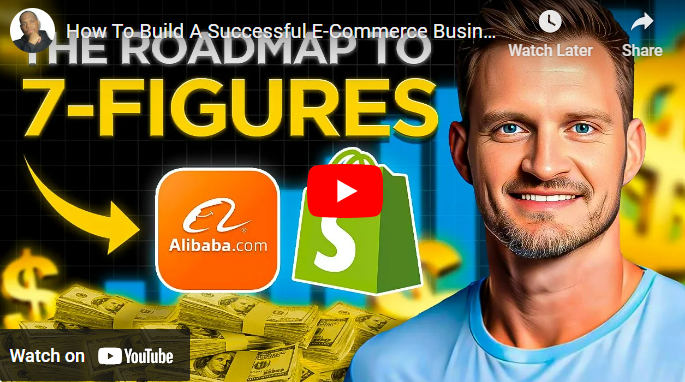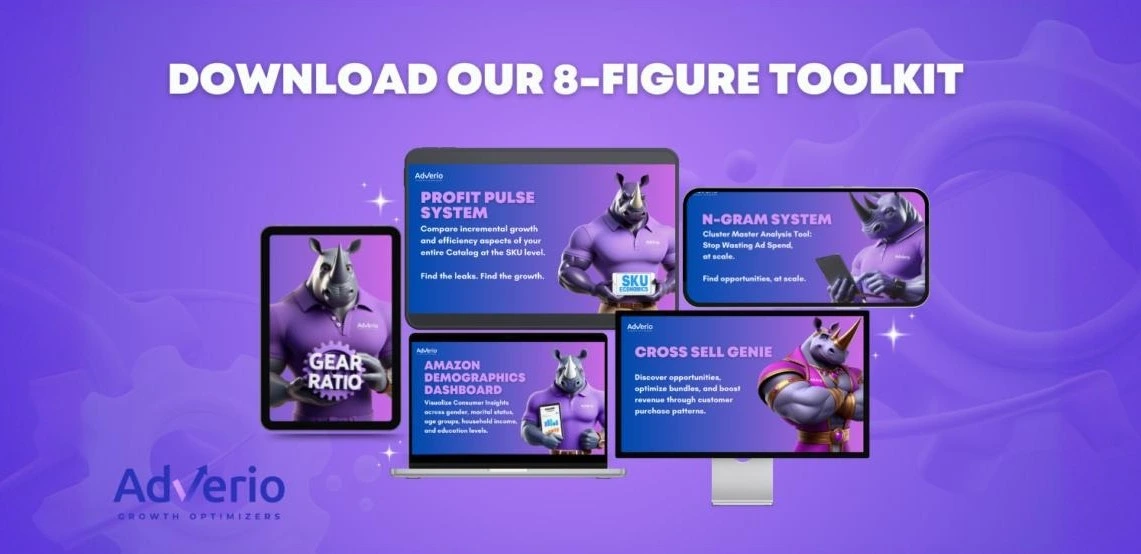New Frontier: AI for Ecommerce podcast
Your AI Power Hour with Max Sinclair and Mike Danford
Mike shares his expertise in leveraging AI to drive e-commerce sales on platforms like Amazon, Walmart, and Target. He delves into various tactical and actionable tips, including using Rufus questions for listing optimization, analyzing customer review sentiments, performing market basket analysis for product development, and leveraging dynamic pricing strategies. Whether you’re an Amazon seller or part of an e-commerce agency, this episode is packed with valuable insights to help you maximize your sales and stay ahead of the competition.
- 00:13 – Exploring innovative AI strategies for Amazon sellers.
- 02:24 – AI is integrated across all departments to enhance processes and scale data handling.
- 06:09 – Exploring AI integration for effective data analysis in Amazon selling.
- 08:06 – AI enhances data analysis for Amazon sellers through diagnostics and predictive insights.
- 11:57 – AI struggles with accurate data analysis and visualization for Amazon sellers.
- 13:53 – Evaluating AI confidence scores can reveal potential hallucinations.
- 17:23 – Effective AI use for data analysis relies on precise instructions.
- 19:24 – Utilize AI for enhanced data analysis and automation in spreadsheets.
- 22:48 – Utilize AI for effective Amazon listing optimization and brand question management.
- 24:33 – Utilizing AI for optimizing Amazon product listings efficiently.
- 27:47 – AI can misinterpret product reviews for Amazon sellers.
- 29:40 – Utilize AI insights to improve Amazon seller strategies and competitor analysis.
- 33:15 – Leveraging AI enhances insights for Amazon sellers’ product bundling strategies.
- 34:52 – Utilizing AI for advanced analysis of Amazon seller performance.
- 38:21 – Utilize competitor data and metrics for effective product bundling strategies.
- 40:04 – Utilizing AI for dynamic pricing can enhance competitiveness for Amazon sellers.
- 43:26 – Strategic pricing adjustments can significantly impact Amazon rankings and sales.
- 45:16 – Strategically adjust prices and utilize AI tools for Amazon selling success.
- 48:55 – AI can enhance data analysis capabilities for Amazon sellers.
- 50:47 – Utilize flowcharts and spreadsheets for efficient management in Amazon selling.
[00:00:00] Jo Lambadjieva: I have to say, I’m not going to get tired of doing my little dance, Max. You have to join me one time. Can you please? I
[00:00:16] Max Sinclair: think, yeah, for the, for the podcast listeners, they need to tune into the, uh, YouTube or LinkedIn live and see Jo’s dance. She does every week. But, um, yeah. Hello everyone. Welcome to another episode of New Frontier.
Um, we have this week with us, Mike Danford, who is the chief strategy officer at Adviero. Uh, he plays a pivotal role in driving innovation strategies for sellers on Amazon, Walmart, and Target. Um, he’s helped, uh, multi million dollars with e commerce sales. and is renowned for his expertise in, you guessed it, AI.
The, and uh, this week I’m very excited to be, well, we’ll, we’ll bring him on stage, but we’re very excited to be talking about lesser known ways to help Amazon sellers of AI. Um, so Mike, welcome.
[00:01:08] Mike Danford: Max, thanks so much. Thanks for having me. Yeah.
[00:01:13] Max Sinclair: Um, it’s good to see you and you’ve just come back from a, from a nice, uh, long weekend, but before we kind of dive into the topics, do you want to give like a Uh, I don’t know if I covered everything in the introduction.
Do you want to do you want to add, uh, add to that at all?
[00:01:26] Mike Danford: Sure. Why not? Thanks for the introduction there. Uh, so I was in this space for about 10 years, started, went through the Amazon or amazing selling machine. Um, got my feet wet there, started in kitchen appliances and tools, if you will, and then realized, you know what I was doing, uh, it’s not something I had much of a background in.
So I went into supplements and graphic apparel. Um, how to blast through that lot, learned a lot. And then at the same time I was doing private label, I was also retail arbitraging, uh, Nike shoes and apparel. So that’s kind of where I started to have fun and understand, you know, how to manage larger catalogs with lots of different variants and sizes and kind of understand, uh, customer trends and how to kind of mitigate those and take advantage of those moving forward.
And, uh, one of my first internal hires was around advertising. And, you know, at that time it was a lot simpler than it is now on Amazon and other marketplaces, but it was still one of the really expensive, no higher expenses for me. And I was like, Hey, this is numbers. I can figure this out. So I did started doing it, posted some results on Facebook groups and whatnot.
And folks started picking it up and like, Hey, would you do it for me? Of course we’ll pay you. And then kind of the rest is history there with the agency board. So,
[00:02:41] Jo Lambadjieva: yeah, I guess what I would love to actually dive in, and this is generally what we do with every episode, is just let’s talk about AI. Um, and so I guess my first question is actually, how do you guys use AI in AdBurial? Like, what is it, what have you embedded in within your agency processes?
[00:03:02] Mike Danford: It’s, it’s really in almost every, every department right now for internal use, external use.
Uh, we, we try to build things in house to kind of answer our own questions and then figure out how we can do those at scale. Um, you know, a lot of goals for us are how can we do more with what we already have. And then how can we, you know, process larger amounts of data that we historically couldn’t. Um, and then we also like to test our bias against it.
Hey, this is an untrained model, and this is what we’ve been training internally or what we’ve kind of thought over the years. And it really helps to get rid of those hidden biases or kind of surface those hidden biases. Uh, and have you think about it in different ways? Um, you know, for me personally, it’s getting involved with, you know, big data or largest data sets to understand what’s going on.
And then, uh, NLP is one of the areas that I really like to get into and try to understand how to leverage that. across different things. We’ll talk with those in a few minutes here. But, um, there’s it’s getting less and less parts of the business that don’t have some kind of a I infused into him for sure.
And then it’s just, you know, how can we empower more of the team to to use and play with? Have a sandbox, if you will. And, um, it’s fun. There’s a lot. It moves really fast and was faster than pretty much anything else I’ve ever dealt with. But it’s It’s it’s great to see everyone kind of going in and, uh, head first and just kind of figuring it out and sharing that like, you know, does a pretty good job of giving some transparency and sharing that.
So that’s really exciting to see as well.
[00:04:29] Max Sinclair: Yeah. I mean, on on this speed, um, we had norm, uh, from lunch of normal podcast last week and I, you know, everyone always compares AI to the internet. And I said to him, uh, yeah, I’ll prove that. And he’s like, well, it’s not a fair comparison because AI just moves. you know, 10 X fast on the internet, which is, which is super interesting.
So do you, do you have any technical talent in the agency? Do you think you’re going to be hiring? Like, do you see like the future of these kinds of companies are going to have like technical head of science and this kind of position in?
[00:04:58] Mike Danford: Yeah, we have some data science. A lot of it is knowing, you know, what we’ve learned is really having them only focus on one code, one language, one, one pipeline, if you will.
And now it’s, it’s all about, Hey, they’re working on this project over here. How do we link these two teams together? Um, without, you know, influencing the other, uh, and then understanding when, when do we bring certain models in, um, so that we don’t develop too fast or the cost isn’t too high. Um, et cetera.
So that’s really big. It’s kind of like, how do we stage this? And yeah, so we have more, I mean, I have a dedicated full time data scientist that works directly with me. I mean, all day long, we’re talking to different things, different projects going on. Um, and that started probably earlier this year. I was like, I need it.
I need a full timer finally. Um, and then we have other teams that work on the, you know, the BI and the representation and reporting for our brands, uh, which is different. It’s more like managing large data sets, um, how to visualize it, how to stay involved, how to. Um, you know, it’s just a different side, the visualization of it and how to allow us to communicate with the data, uh, to bring it more of a GPT style where anyone on the team can come in and just kind of chat with it as opposed to having a more technical background and having to get into the code in the back end.
So that’s definitely the where we’re at right now.
[00:06:13] Max Sinclair: And just to jump in before you ask, how many people, how many people in the company? Do you mind me asking? Like, how big is the company at the point where you guys say we’re going to go and get data scientists in this agency as well?
[00:06:24] Mike Danford: Uh, you know, once we had a couple of dozen, I would say in, um, that’s where we started bringing on more and we’re trying to understand what is the ratio now, you know, we have certain number of brands and we have a catalog manager based on that.
We have a brand manager based on that. So now we’re thinking like data scientists is probably going to start being a part of that equation as well. We’re not there right now. Um, for, for right now, we’re able to, to maintain to our point earlier, I can’t keep up. So I, I don’t know if I can have more data scientists involved in answering more questions because it’s still, I’m a bit of a roadblock, um, for us right now.
[00:06:59] Jo Lambadjieva: I have to say like the, the whole sort of implication of using AI for data analysis, super, I find it super fascinating and actually. A lot of our listeners are also Amazon agencies. So actually your experience and like your case studies will be really helpful. You might be asking just a little bit more concrete.
Can you give us some sort of like concrete case studies or use cases of how you have integrated, let’s say, AI with your reporting function or your analysis function. Like how, how does it actually work? Cause you know, we, yeah, I’m really, really keen to sort of drill into like the nitty gritty.
[00:07:40] Mike Danford: Yeah. So one thing that we’re working on right now, we call it Amos, uh, Amazon marketing operating system, I think is what we’re going to land on hopefully.
And basically it’s, you know, taking a lot of flow charts of, you know, where are things going directionally and otherwise, and. You know, a lot of data. There’s a lot of decisions made on data. You know, is my conversion up down is my click through up down price change, competitors, price changing, et cetera.
And being able to pull all that in where it would take, you know, several hours for us to dig in and pull those disparate data pieces together, answer those questions from, uh, you know, the actual platform to your reporting to a back end report, et cetera. And now there’s being able to communicate with an interface that says, Hey, run this diagnostic and then give me, you know, three or four different ideas and things that are going.
And for us, There’s a lot of questions that are less black and white to where we’re trying to get the machine to kind of be a little more intuitive. Uh, one based on again, what we train it and others to be like, Hey, this is how we look at it, but look at it your own lens based on what you have and tell us if we’re, if it matches or not.
Um, so that’s been fun. It’s kind of like, you know, head to head us versus the AI to see if we come up with a similar answer or different and how we got there. Um, and then another thing for us,
[00:08:55] Jo Lambadjieva: who is, who’s winning so far? I mean, is your team winning or the AI?
[00:08:59] Mike Danford: Well, I’ll tell you where the A. I. Loses and I don’t know.
I know Max and I talked about this. It’s more of the hallucinations. So we have, you know, my understanding of A. I. At its basic level, it’s just a prediction machine. It’s giving you the answer it thinks you want based on the inputs and etcetera. So it’s been told to be really confident and have a lot of bravado, right?
So what we started doing in the beginning, at least in our own is we have it display to some extent, the confidence that this is the correct answer. And if it doesn’t have a certain level of confidence, then tell us, Hey, this is what I think, but it’s a 30 percent chance or 80 percent chance or whatever it may be.
And that’s been really fun. Um, That’s brilliant. I’ve not heard of that. And that’s a
brilliant
[00:09:45] Max Sinclair: idea. Sorry to interject. And it doesn’t do it accurately. Will it say, Oh, I’m low confidence on this. And then it’s, it’s, it turns out that it’s just giving you a hallucinated answer.
[00:09:55] Mike Danford: Yeah. So it’s a little bit different.
So when you go into a GPT or Merlin or any of the cloud, whatever, whatever interface you’re using, I’d be, I’d be curious. I haven’t tested in a while. It’s probably been about a year since we moved really to our own and developing on our own and bolting it on and having our own identity sets. we had to, we had to force it to understand what we’re saying and that it’s okay to tell us if you’re not confident.
So in the beginning it knew like we didn’t want, it didn’t want to tell us it was not confident because it would be in trouble. Right. Um, so that’s been fun, but. You know, I don’t know if they, if you, when we first started asking, uh, GPT, um, I guess, open AI in the beginning, it, it wasn’t allowed to tell us.
And we finally started being able to get it. And now we have kind of a metric in our end. I don’t, that’s getting a little more technical than I do. That’s what the, that’s what the engineers do. Uh, but it is pretty confident. We’re trying to figure out what the threshold is to where we just accept it, regardless of what the threshold is.
But it seems to be different. Um, and then you can have it sites or reference where it’s getting the source from that’s pretty, it’s pretty good. Um, yeah, I mean, it’s, it’s a dynamic process for sure, but it’s definitely given us a better stability in, in, in where, uh, we keep pivoting from when we get a certain answer for sure.
[00:11:09] Jo Lambadjieva: And which GPT are you using?
[00:11:11] Mike Danford: Uh, you know, honestly, I don’t have the answer on all that. I know we’re an open AI for most of our technical. I know we have some stuff built on top of that. I know that our marketing team is really big into Merlin. And using different models based on what we’re doing for AI image generation.
I mean, we have a ton of, uh, rhinos that we produce and those are pretty fun and different platforms. And I know that we use, I think it’s, uh, whatever meadows is. Um, as well, it just, just different depends on what’s being trained in the back end and how it can be used for sure.
[00:11:39] Max Sinclair: So my experience, and I’m going to date this because we need to in September, uh, early September, 2024 is AI is very good at many things.
One of the things that’s not good at is data analysis. And when I was doing kind of, I had to do a bunch of due diligence, um, for, um, from my investors and. Know, I built these models and I try to put them into chat GPT and get it to like, create, um, visualizations of this stuff. You know, so you put in, um, you know, your whatever subscriptions and visualize it and, and try and, you know, show this and it, and I found the hallucinations on data analysis with really, really high.
So, I don’t know, have you guys, have you experienced that? Yeah,
[00:12:29] Mike Danford: it’s good. Joe, you have something? Yeah, so it’s, it’s, we, for the most part, we have to give it some original direction as to what the column is, what it is. You try to, the cleaner the data is, in the beginning, we’ve seen it be better. But when the data is, Uh, coming old or it’s not really structured really well, or you have dates and you’re not really telling it how the two different sets compare like a time comparison, um, that seems to be an issue.
But if you can clean that up, uh, we’ve seen it be better. Yeah. Um, and then for the visualization. Yeah. I mean, there’s some stuff they can throw in there with some Python to give you some, some stuff, but pretty limited, but sometimes it’s, it’s unique way of looking at it. You’re like, Oh, okay. I didn’t think about that.
So, um, again, we’re, it’s part of the process, not the full process, right?
[00:13:16] Max Sinclair: I’ve found on one on the point you made on reference, I found that works really well. So if you use perplexity or Gemini or something like this, and you are trying to get a fact like how many Amazon sellers are there in the US? And you ask it, it’s going to give you, as you say, Mike, it’s going to give you a number that number could be completely made up what is trained, as you say, to do something that sounds good.
And then if you say, okay, point to me the reference in, you know, in the article, sometimes it will just come back and say, I can’t find the reference. Uh, and sometimes it will show you the reference. So it’s a good way of, that’s a good level one test or is this completely hallucinated or not? I, I think you’ll, I’ve never heard of this confidence score.
And I really liked this idea. Michael, the question is. Just just thinking out loud. Um, how do you know if it’s hallucinating the confidence score and it’s just saying oh i’m 30 confident Um, you know, do you have you like have you like do you have you felt that working? I don’t kind of ask this question already.
[00:14:12] Mike Danford: It’s a it’s a great question Uh, and this could be very much gaming us right as we go through Uh to your point, you know, send us the link send us the references if it’s external you’re pulling from which has been great Um, and then the other is you kind of ask it a fact check and the back end of hey This is what we’re thinking.
Um, it’s not, I don’t know. I don’t have an answer for you. We haven’t tested it, but I can tell you that at least we’re getting the, the, the, the percentages, as I mentioned earlier, like that’s how we kind of understand that this is a good answer or not, or how confident it may be. I do think it’s pretty good at telling you when it does, when it’s not confident.
I do, we, we are seeing that when we’re like, ah, this is a pretty big guess. You’re like, okay, there’s a pretty big Delta, um, and the confidence whenever it’s close. I think that it’s Because it can’t be verbatim, if it could be verbatim, I think your confidence, the answer be a little better. And I think it’s having to learn like how, how close can I be and like how it isn’t exactly what I found.
How can I say it’s how can I be confident because I’m putting my own spin on it? Um, that’s a great question. I don’t, I don’t have that. Maybe our data scientists will be able to answer that and how they’ve kind of built that and train that model. But I would definitely take that back for sure.
[00:15:24] Max Sinclair: Can I share one more thought and then Jo, I’ll let you ask our topics because we’ve gone, we’ve gone really off piece, but I, I enjoy, it’s a really interesting conversation.
I don’t
[00:15:30] Jo Lambadjieva: think it’s off piece, I think it’s super off piece, like we’re, we’re actually, yeah, no, but we, we have to talk more about AI and, uh, analytics and I don’t think we do that enough. Like, you know, we talk a lot about, so I think this is a really interesting question.
[00:15:44] Max Sinclair: So asking about AI analytics question, I just have an observation that, um, I made, I made this kind of, um, Uh, like charity, uh, the custom GPT’s we’ve talked about this a few times.
We had a great episode on this with Andrew Bell But I made a a custom GPT to just test. Um How you know is linked to what we can talk about how your um, how well an amazon listing is on Cosmo. And, you know, we have this disclaimer in the GPT, and I’ll say it again, it’s not connected to Amazon, it’s just taking like, it’s reading the science papers, it’s reading some data we’ve given it, and it would do a one to 10 score.
And actually, the scoring works. So like, you go on a list, it’ll give it, you know, we’ve given it what score it on. So like, if it’s got a lifestyle image of a target audience in it, and it explains like how you use the product, like all the stuff in the science paper, give it like a 10. And if it’s got no lifestyle images, and you know, no bullet points, give it a one and it can do scoring.
Well, so like you, you use the GPT and you do the scoring and it will get, like, it will give you a score. Like, I don’t know the exact way that it figures out the score, but we’ve given like, when I trade, when I made it, I gave it like, you know, this is what a 10 looks like this, what a one looks like in it and it can do scoring.
So. Maybe, maybe the confidence score does work, but just an observation, Jo, did you, did you have anything in terms of a question? I think,
[00:17:02] Jo Lambadjieva: I think when it comes, yeah, I think it, when I, from my observation when it comes to anything to do with, um, data analysis and, and using, for example, uh, Chats GPT, It’s all about how concrete you are with the parameters or your hypothesis by which the two should be going off on.
Because the reality is that if you’re, if we’re talking about something like chat GPT and you’re using it for analytics, you’re not using really chat GPT, the like GPT sits on the bottom, but it’s really connected to Python. So like you’re using the Like the LLMs use of Python to do the analysis. And so it’s really about, um, how like specific and how, like, how specific you are with your, you’re prompting your instructions and what is the, sort of the root or the flow of, um, steps that you were instructing for the, um, for the AI to do.
And so if you are really generic and say, okay. Give me a graph of this and that. And you’re not explaining enough about the process that he has to go through in terms of thinking. It’s probably going to hallucinate and it probably will hallucinate even if you’re very specific. But I found that most likely if you are very instructional and you reference everything like and your metrics, what it all means, then you get a much more accurate answer.
So it goes back to, you know, you’ve given it parameters. That’s why it kind of. Calculate the score correctly. Um, let’s talk about other uses. Can I
[00:18:38] Max Sinclair: add one more? Sorry, Mike, you’re going to add one more after this. But on this point, what I found really useful is data analysis. is actually it’s very good at Excel formulas.
So before when I was working in Amazon, I had this guy on my team, uh, who literally like I hired him because he was super at Excel. Um, like main job for me is my, you know, as his manager, his main job was basically are you building Excel? I’m not good at Excel. I don’t understand Excel formulas. And I’d go, Hey Mateus, build me an Excel formula for this.
Cause like, it’s really, it’s really hard if you’re not an expert and now it’s amazing. You just, you can like describe in natural language. Hey, I want a formula. This is a use case. This is what’s in cell ABC and it would do the Excel formula and you copy and paste it and it, and it works almost perfectly.
So that’s a really, really good use case on data analysis. Any last thoughts on, on, on this?
[00:19:32] Mike Danford: Yeah. So we’re big into, you know, Google suite or G suite, and we do a lot of macros and sheets and very similar that, you know, the data science, as I mentioned earlier, you know, we’ll go through and has their own process and can go in, you know, I think that was one of the first.
Uh, plugins that I used outside of the actual GPT UI, uh, was something to do with sheets and Excel, et cetera. And that was great to your point. Yeah, I know enough to be dangerous on that stuff. Um, and I’ll go in, you know, kind of, here’s a function I’m thinking of. It’s not working the way that I want. How can you make it faster?
How can you make it lighter? Um, those types of things. So it really helps you take that next level. Uh, and then write out the macros, which is, I mean, that’s getting into coding inside of the sheet. So that’s great. Um, Hey, where is this broken? What’s missing and how do we fix this? How do we make this macro lighter for, you know, our, our users that coming in?
Okay. Hey, I’ve got three different prompts that are going in here. They have to put three different things. I’d love to just get down to two. How can I do that? Uh, it’s always going to give you an answer to, to the hallucinations we spoke about earlier. So you have to run it. It’s going to do what you ask it to do, regardless if it’s the right thing or not.
Um, and I’ll stop there.
[00:20:42] Jo Lambadjieva: I love it. This is turning into yet another gig hour. Very good, very good. Very good, very good. Uh, all right, Mike. So, uh, yeah, I mean, to be fair, like, you know, we want, we like it that way. Like, uh, let’s, let’s not lie, Max. Um, all right. I want to talk to you about, um, I think you guys use AI for a lot around, uh, review sentiments.
Yeah.
[00:21:10] Mike Danford: So we try to look at, you know, again, larger data sets, pulling in the reviews of our products. I mean, Amazon has some of their own in the backend now in seller central and other platforms as well. And just kind of understanding what the sentiment is of your own, what are we missing? How do we improve it?
Um, and kind of getting ahead of. Ooh, this is a bad batch or maybe this is the, what do we have gaps in? What are folks talking about? Sizes, colors, styles, fit, doesn’t fit, et cetera. Um, and then what I like about that now is, I mean, I know you talk about Cosmo and Rufus, but the reviews are now being pulled into, you know, when you go into your Rufus on the platform.
Uh, so we’re seeing some folks manipulate reviews, um, by putting certain contexts in there, at least. We have some, uh, not 100 percent verifiable, uh, proof, but you know, you’re seeing some bad actors come out to comment on other people’s products and vice versa. Um, and it’s, it’s very interesting to see how that works and how to integrate that and how that.
You know, uh, you have a bunch of ambassadors. Now, you have way more ambassadors than you thought. Um, you know, originally, it was like, hey, you gotta look at the reviews, and you gotta read it, and you gotta catch it. Now, you have summaries of the reviews, above the reviews, and then if you go into the, where the FAQ is, certain categories are different, or you go straight into Rufus for the actual listing, um, it will give you exact feedback and where the reviews are.
What they’re saying, et cetera. Uh, and then for us, we like to use is if it’s, if it’s the correct thing, then let’s, let’s bolster it and support it in, you know, our product images, content, whatever it may be, if there, if it’s got a, if it’s going in the wrong direction or it’s, you know, it’s misrepresenting for whatever reason that may be, then we try to update the listing to answer that specifically.
Um, and for us right now, um, you know, context on that rough Rufus, again, we do it live demonstrations with a lot of our brands will go in and say, Hey. Um, here’s how you can play around with your listings and they work with large catalogs. They can’t do it for every, there’s no way to really automate it, at least that we have yet to go into every product and ask it, but it’s great to see one, what are the questions that people are asking and or answering, whether it’s on your website, uh, on your product reviews in your content, images, et cetera.
And then how can we answer as many of those questions across the entire brand? with a single update, one image or one bullet that updates and answers the questions. How fast is it indexed? Does it be indexed? Etcetera. So that has more of that confidence whenever there is an answer. Um,
[00:23:35] Jo Lambadjieva: and just just to jump on that, like do you, for example, when it comes to listing optimization and you want to emphasize on, let’s say one use case or one benefit, do you replicate the same benefit both in images and bullet points or you just kind of keep It’s to one and then you try to maximize your space.
[00:23:55] Mike Danford: So a lot of the brands that we work with will have thousands and tens of thousands of products and they have a plus content that they can apply across multiple product lines or the brand and you get the brand story and a few other things. So you really try to figure out, is this my entire catalog?
What are the subsets of the catalog? And then it’s what’s the lightest lift for me? Um, you know, and now we’ve been playing around with Amazon recognition and understanding it’ll take the first 100 words, um, that are available in an image. And then if there’s anything that duplicated and that goes against your 100, so it’s trying to understand how can we kind of stuff, if you will, images now without being too gaudy and cloudy, if you will, and things that you can put in an image that typically maybe you wouldn’t be able to put in the back end or you can’t speak to specifically.
Um, and we do have some, some, some fringe cases where we’re seeing that get picked up, uh, as well. So again, it kind of depends on the scale that we want, uh, for one of our apparel brands, you know, it’s a very common t shirt with jeans, right? So it’s a question that pops up, but there’s not really an answer in a lot of the product listings and then there’s a gender bias on that and kind of explanation as well.
Uh, so. If it’s again, it’s how can we do it? How fast can we do it? And what’s their system? How, what is their PIM and dam and system that they have set up to? What’s the easiest for them to update their formulas for their listings or bullet points or where it may be. Uh, and then there’s rotation. And then there’s like, Hey, can we just put it in the description because it’s, you know, somewhat hidden.
Can we put it in the metadata? Can we put it, where, where can we put it to your point, uh, without being overly disruptive? Um, you know, now we have brands that will come on again, tens of thousands of products and they haven’t touched their C1 and C2 tier, the bottom tiers that haven’t moved. You go to try to optimize the listing and you got to pull listing down and put it back up or kind of a reset or it goes through it because it’s been so long since it’s been updated.
So you’re like, how do I do this without having to jump over more and more hurdles? Um, so we’re trying to find those cases as well. Don’t have an exact answer. Um, at least as far as I know, I know our SEO team is kind of heading that up right now. But, um, I mean, these cases are endless and it’s just trying to figure out what’s the quickest and fastest way to do it.
Um, yeah, it’s an iterative process for sure.
[00:26:07] Max Sinclair: Yeah, I mean, I’m loving these kind of super tactical and actionable tips that you’re dropping, Mike. So you mentioned just just to summarize, you mentioned The Rufus questions when, when you’re on a listing, uh, and you use Rufus, Rufus will kind of preempt a bunch of questions like your example, does this T shirt work with jeans and, you know, optimizing listings with these Rufus questions in mind, obviously it’s going to help you rank on Rufus, right?
Like that’s kind of the hypothesis and, and what you’re seeing and what we’re seeing. And the second kind of actual tip we talked about is kind of this, you know, we, again, we talk about it quite a lot, but this visual SEO, right? A recognition, it can read the keywords. In the images, you want to have, have that present in infographics and, and, and other places so that you’re, you know, you’re the way Amazon is giving, we don’t know the exact.
Waiting, but definitely more, more weighting towards the images as well as the written context SEO and having both of those with, you know, with the keywords, uh, I’m, I’m not a fan of the word stuffing keywords, uh, but, you know, having, having, you know, having the, the key, let’s say the intent of the, um, of the customer or whatever else, why they want to buy the product in, in, in the image as well as the text is important.
Um, before the podcast, you sent me, you know, going back to this kind of Rufus in question one, you sent me a really interesting example of how Rufus, uh, hallucinates. So do you want to, do you want to go back and go into a bit more details of that example? And
[00:27:36] Mike Danford: you have to refresh my memory a little bit. I remember sending it over and I know it was an apparel thing that I sent to the brands.
Uh, I know your comment was specifically on the hallucinations and I believe it was something, can you refresh my memory? Because
[00:27:47] Max Sinclair: basically it was. You were kind of live interacting with Rufus on on a on a loom video. And you’re saying, Hey, does this? Does this product look good? It’s a t shirt doesn’t look good in jeans.
Rufus goes, Oh, yeah, like there’s plenty of images on the, you know, plenty of people in the reviews have used this product with jeans and there was nothing, you know, I’ve been basically no reviews on the on the ASIN whatsoever. Definitely none people talking about wearing the t shirt with jeans. So it’s um, it’s really interesting to, you know, coming back to the topic we talked about of hallucinations.
Uh, it’s just an interesting thing that’s happening right now
[00:28:25] Mike Danford: Yeah, now I remember that I forgot that it hallucinated it definitely said in the reviews and you know, yeah It
[00:28:32] Max Sinclair: says in the reviews
[00:28:36] Mike Danford: Where we’re at right now and I don’t have an exact answer But I think we’re pretty close to having an answer is one.
We know it goes to your website as well So maybe the reviews on the website for that product. I don’t know has it in there. I mean the other part is I think it’s what I mentioned in my video is okay. Yeah, what’s that?
[00:28:55] Max Sinclair: That’s a generous interpretation. I think it’s connecting externally and looking at external reviews.
[00:29:01] Jo Lambadjieva: It’s that smart max, obviously rufus is that smart. Yeah.
[00:29:04] Mike Danford: Yeah
[00:29:06] Max Sinclair: We
[00:29:07] Mike Danford: can come back to that maybe not on this episode, but i’ll show you an example, uh, but anyways,
[00:29:11] Max Sinclair: okay Well fun fun. Yeah
[00:29:12] Mike Danford: the um, so I I think what my my hypothesis on this is that the brand has other reviews and other comments. That’s what I mentioned in my video because we do have repetitive after time pictures and we even have images of certain products where the male or female is wearing jeans in the, in the image, et cetera.
So I think it’s picking up some, some fringe interpretations, if you will. I’m okay with the assumption. Um, you know, but in that, in that moment, and that’s what we’re trying to share brands is like, go, go and play. Ask one, see what, look at the bubble, see what it’s popping up. So you kind of understand what the category is.
Also, go to your competitors. I believe I did that in that video as well. See what they’re getting asked. If you’re getting asked the same question, see how it interacts and how it responds. And is there an answer? And when there’s not an answer to something that’s common, give it an answer. Try to answer those questions.
Um, and so that’s where we’re at right now is that’s kind of the process.
[00:30:08] Max Sinclair: And I would just add to that. I think we Currently, the current AI like GPT 4. 0 is probably one of the most advanced ones, but, you know, Amazon will not be using that, but they’ll be using something, something, you know, they might
[00:30:23] Jo Lambadjieva: be using, I would
[00:30:25] Max Sinclair: imagine for Rufus, they built their own, like entirely their own thing and like train their own model.
Um, but anyway, I think it would like the rough, roughly like the kind of performance will be as good as GPT 4. 0 or worse, right? Um, but. If you listen to what OpenAI is saying, like they know, of course, they know these hallucinations are a problem. They’re trying to go to AGI and like the next step towards AGI is that our agents, right, who can like, rather than just like, uh, predicting what you want to hear, like the next words, like what are the most likely next word to make the user happy, as you said, Mike, um, they’re actually going to kind of understand the, um, understand the query and break it down into different sections and then complete those sections.
And this will be like GPT 5 or 6 and then, then the hallucinations, these will, these will go like, it’s just a, it’s a, it’s a feature of like, uh, of the LLMs that we’re using now, but like all the major scientists are saying like LLMs are actually a really bad way of doing stuff and like, they, you know, they’ve got different models, which are, which are kind of live doing now, which are not going to hallucinate.
So I would say like, this is kind of a very much. You know, Q4 2024 thing. And like, if we’re doing this podcast, you know, in, in 2025, like mid 2025, like no one’s going to worry about this anymore.
[00:31:51] Jo Lambadjieva: Yeah. I mean, I think this is, this is the whole point is like, you know, you, they, they let Rufus out so that as many people can use it as possible and learns and becomes smarter and smarter.
I mean, If we think about where it was, even chat GPT 3. 5, like a year ago, and it wasn’t, I mean, it was smart, but it was still hallucinating like hell. And so where we are in like a little more than a year since then. So I think that, yeah, the whole idea is that the more you people use it, the more also people add context to their listings, the smartest going to get.
And then I think it will be. Probably in just a quarter, it will be far better.
[00:32:32] Max Sinclair: So, Mike, the other thing that we kind of, so we talked about customer, anything you want to add on customer review sentiments and kind of using Rufus for that on this topic?
[00:32:43] Mike Danford: No, I mean, let’s see, we’ve got some other projects, but it’s a little early to speak to technically, but yeah.
So the,
[00:32:49] Max Sinclair: the other kind of one of the other kind of discussion topics that you mentioned, you know, a lesser known way of using AI is this market basket analysis for product development. So do you want to dive into that?
[00:33:00] Mike Danford: Yeah, absolutely. So we again, we worked with large catalogs, which is actually good. So we get a lot of data and it’s simply Amazon’s market basket analysis where to give you the top two other Asians that are purchased and combinations, etcetera.
And we’ve built a dashboard for that, and we give it out for free and whatnot. And then we don’t, we aren’t able to layer in our AI machine, if you will, on top of that. But You know, it’s, it’s really good of showing, Hey, this, this asian is commonly purchased with this asian of these sets of Asians. And that’s great.
And you can kind of go in and you can sometimes get the brand. Um, and then if you’re able to pull the title in through some other data points, et cetera, you can pull it in. Uh, what we’d like to go is looking outside the brand and the ace and what are the frequent purchases of other different types of products.
So I gave an example a few months ago, you know, we have a brand that’s selling, uh, sage sticks. And you go in, you can see that, you know, one of the top commonly purchased is a sage stick with a Palo Alto stick or whatever you’re going to look and it looks like it’s like, okay, that’s one brand. And it’s, you know, 2 percent of the total combined cells.
When you go back and you look like, holy cow, it’s like 30 percent of all of the cross cells are Palo Alto sticks or something of that nature. And then you ask the brand, Hey, uh, do you produce this? Can you, can you produce this? Do you, do you make this? And the answer is no. And you’re like, well, you probably should.
Uh, figure out a virtual bundle, add it to the listing, et cetera. So, uh, and then a brand since that as, as now, um, released that in the market baskets, uh, much higher, you know, the average order value is, um, much higher if you will, and it’s just those little insights and how to get that larger set where the human would be very difficult to go in and look at all that and pick up those little nuances outside of those.
Um, and then it’s, I mean, there’s a lot of other things we can do in the market basket analysis, but for us, it’s, it’s when you have thousands of ASINs and you can show these matrices and heat maps and stuff, it kind of helps you guide and understand what that is and like what statistical significance and things you can’t just visualize in a single, you know, view, if you will.
Um, It’s a dynamic process for sure. Some brands are more into it than others. And we also kind of pull in the product opportunity, explore and a few other uh, data sets. So we’ll kind of pull into that, um, which is pretty exciting, um, as well. And then, you know, the, the search query performance, just kind of layering all that data in and then kind of having it, uh, You know feed off of each of the reports and kind of marry it together.
That’s the fun part right now It’s like how can these reports come together to be more informed and individually so Um, and that’s kind of where we’re playing around with it for sure
[00:35:32] Jo Lambadjieva: So do you do you feed this all in in one centralized dashboard or do you fit it into let’s say? a model like, uh, GPT and then try to like, uh, categorize in some way, mash it up.
Like how, like, how are you using then the AI and how do you like process all of this data?
[00:35:51] Mike Danford: Each brand is a little different. So for now it’s, it’s definitely separate. It’s just easier. It’s lighter, manipulate, ask questions and it’s, you know, more standardized if you will. Um, and then it’s one understanding what the brand can and can’t do.
How fast can they produce something? Are they, are they hungry to find new products or they want to just kind of improve the ones they have? How easy is it for them to come up with a new formulation or, you know, all of that process and then what’s their goal and et cetera. And that’s kind of the, it depends answer, if you will, uh, you know, again, as I mentioned, it’s, it’s, we’re trying to figure out when to pull all of it together.
What’s the best way to pull it all together? Is there a particular order to put it together? That’s better than the others kind of building that recipe, if you will, and that flow of how to communicate, um, and that we love when we get the question again, we work on an apparel and they’re like, Hey, uh, we’re in this, you know, sub niche and style of apparel or shirt or design or whatever it is.
Um, We have thousands of more reviews were price comparable, whatever. But this other design or whatever is taken off, uh, and these types of reports will help you see that, um, helps you kind of understand how can you put certain styles and designs together where they’re looking for this. And yeah, it’s not the exact same thing, but it’s so close to this over here.
So you can kind of piggyback that as well. Uh, so it’s a lot of bundling and emerging and, and, and being creative in how you, um, stack the attributes for a particular parent, if you will. And then it’s combating Amazon. We have an, uh, a betting brand that is constantly getting their parents broken apart, where it’s like a style design, if you will, but they have a quilt or they have a comforter and they have a devay and Amazon wants those separately.
Um, and that. Kills the basket value. So we’re trying to like record those and show and say, Hey, Amazon, stop breaking these apart because it’s actually making you less money because it’s making us less money. Um, that kind of thing. So, uh,
[00:37:45] Jo Lambadjieva: I
[00:37:47] Mike Danford: don’t know. Similarly, we’re also trying to feed back anything that we have into Amazon seller support, trying to get it up as high as possible, you know, put it in a queue, but we’re kind of hands tied, if you will.
Um, yeah. And the other is I’ll stop there. I’ll stop there.
[00:38:02] Max Sinclair: So you’re using, just so I can understand, you’re using data to understand what bundle listings you should create. Either new listings or like new products or just existing stuff, bundle it together.
[00:38:15] Mike Danford: Both, yes.
[00:38:16] Max Sinclair: What are some of the key, like, metrics and data that you look at that informs you to say, hey, like, X should be bundled with Y?
[00:38:25] Mike Danford: Uh, first, it, it, are your products commonly, are competitors products commonly being added to your products? And you offer those products, yes or no? And if that’s the case, and that’s the easiest thing, you already have it live. Do we virtual bond it? Do we do we bundle it? Do we merge it together? Do we create a new parent?
How what’s the easiest lift, fastest way to do this? And then, and then can you do both? And then the other is okay, 30 percent of your orders that are purchasing your product for this, whatever it may be. Your your competitors are putting these in there. Can you do that? And it’s really that order It’s again It’s the the the light the weight of the lift the speed of the lift that you can do And what’s the cost to do that?
Is there a way to kind of trial it? Etc. And it’s it depends. We have brands that launch product like hundreds of products every single month And they’re more of a spaghetti on the wall Approach where now we’re like hey look at your product opportunities for to help that infuse your, you know, throwing less spaghetti on the wall or more cooked spaghetti on the wall.
I hope those analogies work, but it’s, Amazon’s given us way more data than it used to. It doesn’t do a good job or generally doesn’t give it, they don’t do a good job of representing or visualizing it or putting it together and organizing it. So we’re trying to do that as well. And then what can you do with that?
Um, and if you’re not doing anything with it and you’re missing opportunity, we also have to be careful not to have shiny object syndrome where we’re constantly chasing whatever’s being out and be like, eh, it’s kind of nice, but what am I able to do with this? Um, that’s definitely, uh, you know, the second, the double edged sword, if you will.
[00:40:02] Jo Lambadjieva: Super interesting. Um, I actually want to touch upon another topic that I think a lot of sellers are thinking about struggling with, which is pricing. So, um, are you guys using any sort of AI or just general pricing tools? Are you using any AI to analyze pricing? How do you tackle that?
[00:40:23] Mike Danford: Yeah. So we, we work with some vendors right now.
We have a couple of head to heads on different catalogs and brands, different price points to, to, you know, the, the, the term is dynamic pricing. And I just saw a report, I think it was this morning or yesterday, how, you know, the fortune 500 companies are speaking about dynamic pricing and surge pricing based on demand and et cetera, kind of like Uber, et cetera.
I’m just trying to figure it out. And. You know, a lot, a lot of brands that we work with when we come in, we’ll ask like, Hey, when’s the last time you updated your prices on, you know, your, your, your bottom tier of your products? And they’re like, Oh, we haven’t done it. It’s been a couple of years. It’s been a year.
It’s been six months, et cetera. So we’re trying to, you know, everybody’s all about advertising. If they’re advertising, they’re all about testing it and moving it and pulling all those levers. And then the next more complicated piece sometimes is getting a budget towards optimizing the listing. And actually, I think that what the Cosmo and the Rufus in that.
integration directly in the listing. I think that’s actually making it easier to pitch and understand. Hey, You gotta, you gotta, it’s, it’s here. You have to do something. Uh, so you gotta get a little sliver of their budget for that. And the last one is dynamic pricing. And it’s, you know, in the beginning, it’s, you know, repricing is all about trying to win the buy box against your competitors, etc.
But dynamic pricing is more about what’s going on in the market. What are you trying to do? What’s your supply and demand? Uh, what’s your demand? Elasticity, price, elasticity and understanding those, um, a lot of brands do, you know, they’ll make the, the jump sort of deltas in the pricing too big, or they don’t do it for long enough, you know, to, to have a good, you know, uh, amount of data to understand and too much recency bias versus data, you know, validation and, and, uh, confidence, if you will.
So. Also, you don’t have to, uh, little things can go a long way. Pennies on a up or down on a product can make a big impact. And it’s also about like pulling in what your competitors are doing. And in the part that we’re trying to get into right now that these service providers, I don’t, we haven’t seen it yet.
We’ve kind of run it by them to see if they can do it. It’s, it’s, it’s, it’s difficult is. Downloading the last couple of years of pricing data for your competitors and seeing, this is where the AI comes in, seeing if you can figure out their cadence, like, okay, they are, they always have a promotion this week, or they always do a promotion every six weeks or, hey, based on their inventory levels, their pricing goes up or down.
So can we like pull that in and be like, Hey, they gave me a price hike or dropped their price. One, should we follow, should we beat on it? All of that’s being brought into it now. Um, And it’s, it’s, it’s really, I was talking about the other day. It’s kind of like the new PPC. It’s the new game of bidding your, yeah, your, your, your bids are in PPC, if they’re for placements and such, but your price is kind of the same way as well.
Um, and it’s a little early for us. We have some, some great. Um, data, you know, as another way to add the bottom to the bottom line when they’ve already maxed out their, their advertising, or they’ve got a good SEO plan in play, product launches, et cetera. It’s just another level to pull that I wish more well, maybe I don’t want more sellers to pull it unless they work with us, but, um, it’s an opportunity for us right now and it’s, it’s fun.
So, um,
[00:43:30] Jo Lambadjieva: Just, just to jump on this, like I, when I’ve analyzed. Some of, some of my clients, uh, pricing, what I sometimes spot is that even just changing, um, their pricing with a couple of pennies down has such a dramatic effect because obviously Amazon somehow makes it in their algorithm in terms of ranking, and it can literally just shoot you up in terms of ranking just because of those few pennies.
So you don’t have to like really sacrifice on margins. It’s almost just seeing what is the sweet spot between obviously. consumer psychology about price and also the Amazon algorithm.
[00:44:07] Mike Danford: Yeah, getting that, you know, lowest price in 30 day badge by just flipping it down a few pennies is, is remarkable. Um, and then charm pricing, I mean, some brands swear by it and charm pricing is another ending in a nine or eight, seven, six, whatever it may be.
Uh, and playing around with that and, and kind of debunking it. And then, you know, we have a lot of brands that are afraid to increase their price and like, Hey, we’re going to do it. Let’s, let’s see what happens. Uh, so we just had a brand in the CPG, you know, kind of a really healthy CPG products, uh, you know, nature, uh, keto, all the clean stuff and.
It’s considered a premium brand. It’s a premium product and, and, and the audience kind of knows that, but they were scared to kind of go into that. So I think they’ve added 15 percent or so to their price. They’ve had the price pretty consistent for three or four years, and it’s actually increased the purchase rate just by showing that validity and understanding the real genuine ingredients.
It’s like, we don’t know. There’s a lot of interpretation. We have to run focus group to find out, but, um, It’s, it’s also helped create the, help them have the assurance and not be afraid to move the price up or down. Um, and I say this where a lot of people are concerned is like, once I lower my price, I have to stay there.
No, it’s, it’s, it’s okay. Um, You can move it back up once it’s moved up and it’s like, how much can you move? It’s a big question. They don’t really understand. So since they don’t understand, they just don’t do anything, which I think is the worst thing you can do.
[00:45:30] Max Sinclair: Yeah, Mike, I think this has been one of the most tactical and kind of actionable podcasts we’ve done.
And just, I’d say anyone listening, if you’d like to give us, give us five stars and follow for more. But, um, just to, just to read back to you, the notes I’ve taken from, from your tips, number one. Get confidence scores or start experimenting with confidence scores for your GPT answers number two Use, uh rufus questions, uh to optimize your listing go and see what rufus is asking and kind of work that in Uh, that’s going to help with you know, optimizing for cosmo and in intent based matching number three um add Text to images for for record night.
I think lots of people kind of covered this, but you know, you mentioned it again. It’s something really important. Number four, um, use AI to do basket analysis of what competitors what what customers. what customers are adding competitive products and do that for bundles. And number five, do kind of use AI again with the analysis to understand the cadence of competitive pricing.
[00:46:42] Jo Lambadjieva: I have a feeling that Max has been a very good student at school, and you know, he’s an avid notetaker. I was, I was a
[00:46:48] Max Sinclair: straight A star student.
[00:46:50] Mike Danford: Uh, anyway, um, so any other questions? Did you use an AI notetaker for this, Max? No, no, no
[00:46:54] Max Sinclair: AI notetaker.
[00:46:55] Jo Lambadjieva: Obviously
[00:46:56] Max Sinclair: no AI notetaker, I just, um, anyway. My question, there’s a question here.
Any other actionable tips beyond those ones that you want to share as we come towards the end?
[00:47:06] Mike Danford: I mean, there’s, there’s so many, uh, you know, just don’t be afraid of it. It’s, it’s not going anywhere. And I think for us, what we are trying to learn, we talked about earlier in the episode is it moves so fast.
So, and I believe it was Jeff Bezos, I need to answer my, I need to go like find out the answer to my question or my comment here, but I believe that he mentioned, you know, how you, you had that competitive advantage and edge is not focusing on the shiny new things and things that are coming up, but focus on the things that are going to be here for 5, 10, 15 years and doing those and having those foundational blocks.
So it’s, as I mentioned earlier, the reason that we’re focusing on these certain points is customers are always going to be sensitive to price. That’s not going anywhere. Right. They’re always going to have questions about the product. The more answers that you can provide before they purchase, uh, the friction reduces, um, and then the customer service is much better.
So it’s like, let’s focus on those things. These are awesome and powerful tools that we’ve been given. We didn’t have these. You know, a year and a half ago, a year ago, um, you know, and go pre COVID, et cetera. And it’s just using them to answer more questions, uh, for yourself internally as well, uh, speeding up your processes.
You know, I don’t, I think a lot of folks have a fear of, you know, there are certain roles that will be obsolete, but I also think that they will be elevated. Um, the, the level of a developer, um, skillset now is going to be elevated. They can do the more complex part that we’re talking about where the machine can’t do that, but it can do the, the simplicity, uh mm-hmm.
The simple or the lower level, uh, tactics, whatever it may be, coding, whatever it may be. Um, and I think it’s just embrace it. It’s not going anywhere. Yeah. Uh, my wife has been anti ai. She’s in the medical space, and my
[00:48:45] Jo Lambadjieva: husband as well, he’s very anti ai, so yeah.
[00:48:51] Mike Danford: I enjoy it. Um, I think it’s create, you know, it’s gonna take on all, it’s gonna be different.
I mean, every six months, there’s another, you know, milestone that’s gonna be hit and we don’t even know what’s coming next. You know, it’s all hypothetical, right?
[00:49:04] Max Sinclair: Yeah, I agree with that. I think, I think people listening will tell from the discussion that like, you know, all of us have experimented this and you can kind of get a sense of what works and what doesn’t.
So like, I wouldn’t trust the AI to build my visual graph, but I would trust it to create my Excel formula, you know, like, and, and, and like knowing that gives you an advantage because it just, you can augment certain parts of your work, right? Like, you know, okay, it’s going to be great at writing my blog, Claude, write my blog, it’d be beautiful.
Um, but. If I’m doing something else, it won’t be Joe, any, any action, like super actionable or tactical tips to add to those five, the, from you that you want to, you want to put in
[00:49:44] Jo Lambadjieva: putting on the spot, I actually would kind of contradict this. So I would say, um, use AI to do like analytical data, like use it.
Um, but you know, just. Know how to analyze data. Like, this is the thing, like, I, this is what I say when, when I train people is you can’t, you can’t expect that, uh, an, an AI tool will be a great analyst if you are not already a great analyst who knows what they’re looking for in data, like how would, how would any AI know what, what is actually an insightful piece of information?
So I think that’s my number one tip is like, you know, just ask, know what you’re asking for. And you, you shall get what you are asking.
[00:50:28] Mike Danford: Yeah, I’ll piggyback that. As I mentioned earlier, if you can give it a flow chart, a very clean set of conditions, it will answer those questions pretty confidently, especially if you let it know where to look, uh, and when to look.
Um, and then once you You’re, you’re
[00:50:41] Max Sinclair: giving ChatGPT a literal flow chart and saying, this is the flow, follow this flow.
[00:50:46] Mike Danford: Yeah. Hey, go, this is, these are steps. Follow these steps and do it a thousand times. In visual
[00:50:51] Max Sinclair: or visual? Like a visual flow chart.
[00:50:53] Mike Danford: Uh, generally in a spreadsheet. Okay, so we feel that that’s been cleaner visual.
You can do it. Maybe. I don’t know. I haven’t tried. Those two systems don’t communicate. The spreadsheets are easier for us to upload and communicate in the back end through the API, etcetera. Python can manage it, etcetera. There’s
[00:51:10] Max Sinclair: a six tip. So flowcharts via Excel to purchase new prompts. I love it. Um, well, Mike, it’s been an absolute pleasure to, to, you know, to talk to you always, you know, always love talking to a fellow kind of nerd in the space who’s just like, you know, fully, fully in and experimenting on so many stuff.
And I think really valuable for our listeners. If people want to reach out to you, uh, how do they find you?
[00:51:38] Mike Danford: Yeah, so obviously on LinkedIn, um, and then if you go to our, uh, adverio. io forward slash downloads or on our homepage, you’ll see free tools. A lot of the tools that we’ve talked about here, a lot of our early, um, pilots are available there free to download, free to access and use, um, as you see fit.
[00:51:57] Max Sinclair: Amazing. That’s very generous of you. I’m surprised you’re not wrapping it up as a SAS thing, but maybe that comes later, but, um, yeah, Mike, uh, uh, been an absolute pleasure. So thank you for, um, thank you for coming.
[00:52:09] Mike Danford: Likewise. Thank you so much.
[00:52:11] Jo Lambadjieva: Thanks
Mike.




